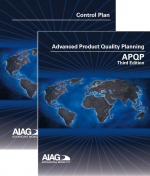This set contains a copy of both the APQP-3 and CP-1.
APQP-3
Focusing on the "why" behind the "what" and "when," the APQP 3rd edition manual addresses how to improve successful new product launches with updates to reflect agile product management and new sections on sourcing, change management, APQP program metrics, risk assessment mitigation plans, and gated management. Along with the removal of control plan content - now a standalone document - further revisions include new information on "part traceability," various checklists, and examples of common analytical techniques used during the APQP process to help enhance your understanding.
CP-1
The Control Plan, 1st edition manual, provides clarification on various requirements, further explanation on linkages to APQP processes, and detailed guidance on how to develop control plans, along with industry best practices for effectively using these plans. Additional updates include the introduction of a "Safe Launch" requirement to control plan phases, examples of developing plans for highly automated manufacturing applications, guidance on using software to develop and manage control plans, and revised examples, tables, forms, and checklists for additional support.

























